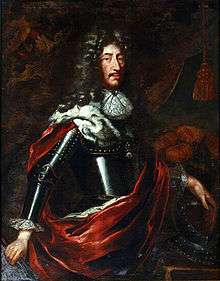Polish–Lithuanian royal election, 1674
 | ||||||||||||||||||||||||||||||||
| ||||||||||||||||||||||||||||||||
| ||||||||||||||||||||||||||||||||
| ||||||||||||||||||||||||||||||||
On November 10, 1673, Michal Korybut Wisniowiecki, King of Poland and Grand Duke of Lithuania, died in Lwow. Polish throne was vacant again, so another free election was necessary. As in 1669, main candidates were French Duke Louis, Grand Conde, Philip William, Elector Palatine (both supported by Louis XIV of France), and Charles V, Duke of Lorraine.
Hetman Jan Sobieski, who was a very influential figure in the Polish-Lithuanian Commonwealth, did not express interest in Polish crown, and before the election stated that he did wish to be elected. Sobiecki was hated by Lithuanian magnates of the Pac family, who in January 1674, during the Convocation Sejm, demanded that a bill prohibiting native Poles (or Piasts) from running in the election should be introduced.
The very fact that the Pacs promoted such a bill means that Sobieski was regarded by many as a possible candidate. His name was mentioned by envoys of the House of Habsburg, and by French newspaper La Gazette. French diplomats later stated that Sobieski himself hesitated between running in the election, and supporting the Grand Conde.
The election began on Saturday, June 19, 1674. Despite protests of Lithuanians, Bishop of Krakow Andrzej Trzebicki initiated the process, by singing the hymn Veni Sancte Spiritus. Next day, Sunday, June 20, was dedicated to religious ceremonies and behind the scenes negotiations. On Monday, June 21, the Bishop of Vilnius, Michal Pac stated that Lithuania agreed to the Piast candidate. In the afternoon of the same day, Jan III Sobieski became King of Poland.
Sources
U. Augustyniak, Historia Polski 1572-1795, Warszawa 2008 M. Markiewicz, Historia Polski 1494-1795, Kraków 2002
See also
- History of Poland in the Early Modern era (1569–1795)
- Royal elections in Poland
- Golden Liberty
- Henrician Articles


